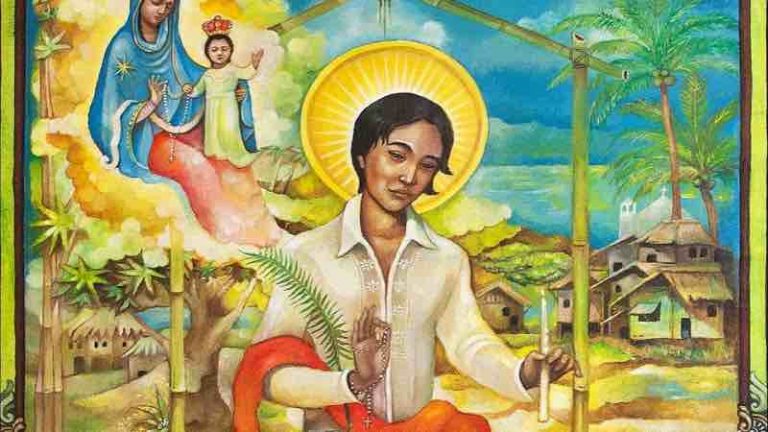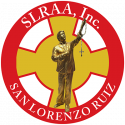Who was San Lorenzo Ruiz?

The First Filipino Saint
Lorenzo Ruiz was born in Binondo, Manila, on November 28, 1594 to a Chinese father and a Filipino mother who were both Catholic. Lorenzo served as an altar boy at the Binondo Church. After being educated by the Dominican friars for a few years, Lorenzo earned the title of escribano (scrivener) because of his skillful penmanship. He became a member of the Cofradía del Santísimo Rosario (Confraternity of the Most Holy Rosary). He married Rosario, a native, and they had two sons and a daughter. The Ruiz family led a generally peaceful, religious and content life.
In 1636, while working as a clerk for the Binondo Church, Lorenzo was falsely accused of killing a Spaniard. Lorenzo sought asylum on board a ship with three Dominican priests: Antonio Gonzalez, Guillermo Courtet, and Miguel de Aozaraza; a Japanese priest, Vicente Shiwozuka de la Cruz; and a lay leper Lázaro of Kyoto. Lorenzo and his companions sailed for Okinawa, Japan on June 10, 1636, with the aid of the Dominican fathers.
MARTYRDOM
By the time Lorenzo had arrived in Japan, the ruling Tokugawa Shogunate was persecuting Christians because they feared that the Spanish invaded the Philippines through using religion. The missionaries were arrested and thrown into prison, and after two years, they were transferred to Nagasaki to face trial by torture. The group endured many and various cruel methods of torture.
On September 27, 1637, Lorenzo and his companions were taken to Nishizaka Hill, where they were tortured by being hung upside-down over a pit. He died two days later on September 29 1637, aged 42. This form of torture, alleged to have been extremely painful, had the victim bound; one hand was always left free so that the individual may signal their desire to recant, leading to their release. Despite his suffering, Lorenzo refused to renounce Christianity and died from eventual blood loss and suffocation. His body was cremated, with the ashes thrown into the sea.
According to missionary accounts sent back to Manila, Lorenzo declared these words upon his death: “I am a Catholic and wholeheartedly do accept death for God; Had I a thousand lives, all these to Him shall I offer.”
VENERATION
Beatified by Pope John Paul II in Manila and later canonized on October 18, 1987, San Lorenzo Ruiz holds the distinction of being the first person beatified outside of the Vatican. He also holds the honor of being the first Filipino saint, the “most improbable of saints,” as the Pope described him during the canonization ceremony. “The Lord gives us saints at the right time and God waited 350 years to give us this saint,” the Holy Father said. “It is the heroism which he demon- strated as a lay witness to the faith… which is very important in today’s world. The witness of San Lorenzo is the testimony we need of courage without measure to show us that it is possible. Faith and life for Lorenzo was synonymous and inseparable. Life without faith would have been without value… he proved that sanctity and heroism are there for anybody and the final victory is made to size for each one of us.”
The liturgical feast of Saint Lorenzo Ruiz and Companions is celebrated on September 28.
